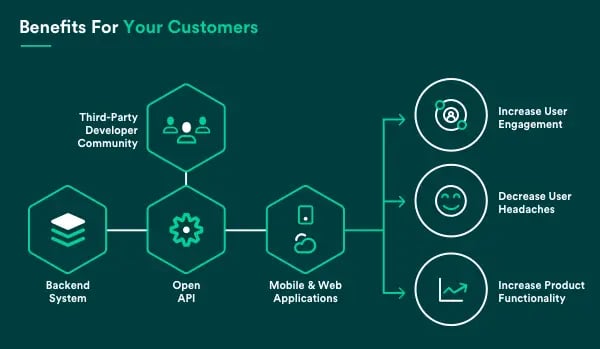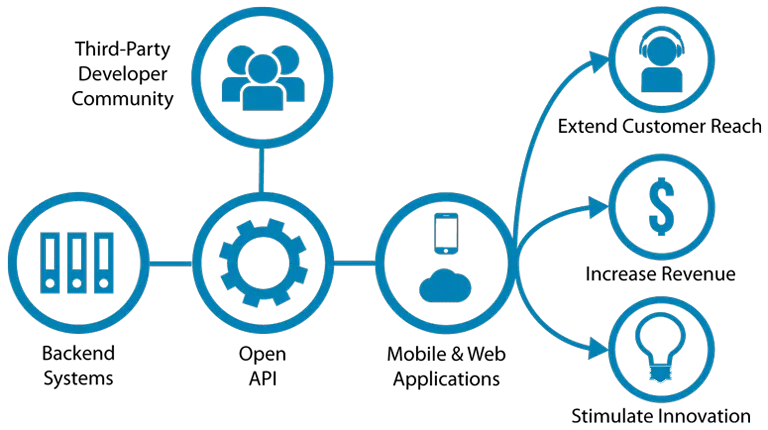
What is an API? In this article, we explore that question, looking at the hows and whys, as well as a series of examples to help you understand.

What is an API? A Comprehensive Run-through and Examples
Talk of APIs is everywhere right now. Most of us use them daily without thinking about them (or even realizing it, for that matter). But what is an API? That’s what we’re going to find out in this article.
Essentially, API is an acronym for “application programming interface”. These software intermediaries simplify the software development process by allowing applications and web services to exchange information easily.
In this blog post, we’ll discuss everything you need to know about the ins and outs of APIs, from what they are to why we require them. We’ll look at some helpful real-life use cases too. So, without further ado, let’s get started!
Definition of API
An application programming interface (API for short) is a software intermediary that facilitates the transfer of information between different apps. You might say APIs allow apps to ‘speak’ to each other.
APIs work behind the scenes to facilitate the interaction between apps, allowing digital products to enhance the user experience by sharing the data, code, and functionalities of other software applications.
So, how does this communication work? APIs enable communication between apps via simple requests and commands. Basically, the API is a middleman between an application and a web server.
A user will issue an API call that instructs an application to carry out a particular action by asking the web server to facilitate it. The points at which APIs connect with their intended software programs are called API endpoints.
APIs are formatted in a similar way to standard HTTP message transmission. One operating system must put the data that needs transferring into a format the other will understand.
APIs are built using programming languages such as Java, Javascript, Python, Django, Spring, PHP, and Laravel. The most common API format examples are XML (extensible markup language) and JSON (Javascript object notation).
API headers provide additional information for each API call. They contain the meta-data for API requests and responses. Headers are formatted as key-value pairs. Here’s an API header example: "key2": " value2".

Application programming interface (API) benefits
API management comes with a tremendous range of benefits. APIs help developers make use of valuable data and functionalities from other software applications to improve the capabilities and levels of customization in their products. The result? A highly customizable experience that users will love.
Other benefits associated with APIs include:
Offers flexibility
APIs enable a great deal of flexibility. Thanks to them, businesses can forge strong relationships with industry partners. When apps are able to share data, services, and functionalities, they can grow off the back of one another, access new markets, and drive considerable growth.
APIs also offer flexibility in terms of what businesses can offer customers. This is because APIs allow organizations to create more personalized services that are directly targeted toward users’ needs.
Enables automation and collaboration
APIs reduce disconnection and enable collaboration by allowing digital platforms to integrate seamlessly. Integrating digital goods like this allows companies to access a wealth of tools for enhanced workflow efficiency, collaboration, and connectivity.
APIs also allow IT departments to automate the process of transferring data between applications. This saves time and resources previously funneled into lengthy manual processes, resulting in greater levels of efficiency and accuracy.
Improves security
APIs aren’t just about sharing data; they also increase levels of security between your data and the server. On top of this, a programmer can add extra layers of authentication to monitor traffic, such as API gateways, tokens, and transport layer security.
Data commercialization
Although APIs are often offered free of charge, there’s also scope for monetization. For example, an API that provides access to great data, capabilities, or other forms of digital assets is easy to commercialize for the API economy. Selling access to these attributes can be highly lucrative.

What is an API used for?
APIs are used as a medium for interacting software to access the data and functionalities of other software.
An API user interface isn’t accessed by app end users directly. Instead, it facilitates accessibility between different software platforms so end users can enjoy seamless application integrations.
From a software development perspective, APIs speed up the development process. This is because developers don’t have to write out each new app functionality afresh. Instead, they can use an API to essentially ‘piggyback’ on pre-existing code.
Five API examples
APIs have so many use cases, and examples of APIs are pretty much everywhere. Most of us interact with them on a daily basis without even knowing or thinking about them.
To paint a picture of just how common they are, here are some real-world API design examples to consider.
1. Paypal's "Pay with Paypal"
When shopping via an online marketplace, it's pretty common to be given the option to “Pay with Paypal”. Instead of completing the transaction using credit or debit card information, users can connect their PayPal account for a quick and secure checkout.
This is possible thanks to an API integration platform. Websites that you might be purchasing from don’t have access to your banking information. Remember what we said about APIs being like a middleman?
Well, that’s exactly what’s happening in this example. A website (such as eBay or Amazon) interacts with PayPal over an API and requests payment. Once the payment is complete, the API confirms this with the website.
2. Bank transaction approvals
APIs can also be used to facilitate bank transaction approvals. Open banking APIs facilitate secure data transfers so financial services providers can offer more personalized products and online payment experiences.
For example, Credicorp, a Panamanian bank, uses OpenLegacy APIs for its Panama Canal Transaction Approvals. Using OpenLegacy APIs allows them to improve overall performance and time-to-market and provide customers with highly personalized care.
3. Insurance real-time quotes
In the insurance industry, APIs are used to provide insurers with access to large pools of data. This enables them to improve the quality and efficiency of fact-checking and risk evaluation processes.
Companies like AIG, one of the largest financial and insurance companies globally, use OpenLegacy APIs to enable better customer experiences by reducing the time it takes to deliver real-time quotes down to a matter of minutes. In this way, AIG has been able to improve claims processing efficiency by 40%.
4. Supply chain connectivity and visibility
APIs are extremely useful when it comes to managing supply chain processes too. They provide access to data and functionalities to make every step, including order processing, run like clockwork.
APIs can improve both supply chain connectivity and visibility. The multinational catering company Autogrill is an excellent example of this. It uses APIs to support its suppliers by providing direct, real-time access to its core systems.
Since most of Autogrill’s data resides in its IBM and SAP systems, it required an SAP API architecture. The company uses OpenLegacy API tech to access data quickly and securely and generate cloud-native microservices for use by its team and partners.
5. Instant discount approval
Another innovative example of APIs in action comes from Champion Motors, a major car importer. The company has used APIs to develop its own discount approval system to help sellers on the sales floor.
Champion Motors uses OpenLegacy APIs to sync up IBM i data between its sales floor and sales manager to facilitate real-time, on-the-spot approvals. By using APIs, the company can approve sales requests in a matter of minutes instead of hours or even days.

Evolve your applications further with APIs
APIs are fuelling digital transformations by making the shift from core systems to API products. Most of us encounter them on a daily basis without even knowing it, with application programming interfaces acting as the middlemen behind our favorite app integrations and functionalities.
Many of the time-saving digital processes we so appreciate (things like Pay with PayPal and social media log-ins like Facebook login) are made possible by APIs working away in the background.
The benefits of this are numerous, from increased flexibility to easy collaboration and high-level security. One thing’s for sure: APIs are now powering an application revolution that empowers businesses, developers, and end-users alike.
The two foremost advantages of an API-first approach, however, are speed and automation, and OpenLegacy encourages companies to embrace these by adopting an API-factory mindset.
This allows businesses to produce APIs on demand whenever they spot a consumer need. The process of producing these is similar to cars on a production line, with a fully-automated “software factory” for creating requirements, APIs, testing, deployment, and iterations (all while ensuring access to legacy-based systems).
This approach drastically reduces the time, cost, and effort required to effect a digital transformation by making the steps in the development process—and the handoffs between them— as straightforward and frictionless as possible.
FAQs about APIs
What’s an API in programming?
In the context of programming, we can think of APIs as a set of programming codes that facilitate the sharing of data between separate software products. They’re made up of two parts. These are (A) their technical specifications and (B) the API interface design.
API specifications refer to the data exchange processes an API can facilitate. The software interface is where the two software applications communicate. Every API has its function calls, which are described in the API documentation. These are the phrases that determine particular actions an application is required to perform.
For developers, one of the key purposes of API use is to speed up the software development process. Instead of creating new code for new functionality from scratch, developers can access already developed code and software components from existing solutions - for example, image recognition or payment processing functionalities.
What is an API in simple terms?
API stands for “application programming interface”. In simple terms, an API is a set of protocols that developers use to build application software. APIs are essentially mediators between digital products or applications.
They enable different apps to create gateways to other apps and ‘speak’ to each other to exchange data, code, and functionalities. For businesses, APIs make it possible to offer customers more flexible and personalized services (e.g. alternative payment gateways to third-party platforms like PayPal).
What are the four main types of API?
There are four main types of API used during web application development. These are public APIs, partner APIs, private APIs, and composite APIs. The type of API required for a particular product depends on the intended use case.
Public APIs are open APIs, meaning they’re publicly available. Any business or developer can gain access to them. Usually, Public APIs (or open source APIs) are accessible free of charge, but sometimes they’re monetized on a per-call basis. The Google Maps API is an example of a public API that’s available free of charge with unlimited usage.
Partner APIs are not publicly available. These are only available to authorized businesses and developers. For this reason, they’re usually used as a way to meet and work with new business partners and share access to data systems selectively.
Internal APIs are sometimes referred to as private APIs. They’re only accessible by one private enterprise and are used to connect and share data between internal systems within a business. For example, a business might use a private API to share data between its private accounting and HR systems.
Composite APIs are an aggregate of multiple APIs. They’re used to facilitate more complex processes by creating a sequence of related actions.
Other types of APIs include.
- Rest APIs
- Web APIs
- Remote APIs
- Service APIs
- C# APIs from legacy assets
What is the purpose of an API?
The main purpose of an API is to facilitate communication between separate applications so data, code, and functionalities can be shared. For example, with an API, developers can transfer information from Javascript to Python.
Likewise, using a rest API lets developers create a single-page application (SPA) using HTML, CSS, and Javascript. Good APIs have a wide range of use cases and can be applied to processes such as creating integrations between applications, facilitating mobile applications, no-code solutions, and more.
One common reason organizations use APIs is for legacy integration. APIs offer a way to quickly leverage legacy assets to deliver digital services. For example, an Oracle API enables organizations to access Oracle-stored procedures.
We’d love to give you a demo.
Please leave us your details and we'll be in touch shortly
